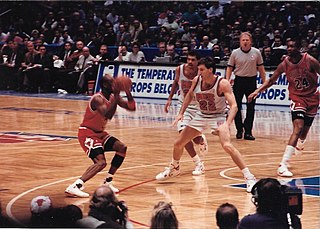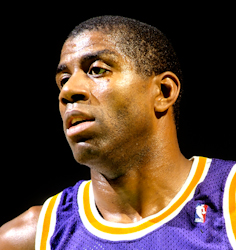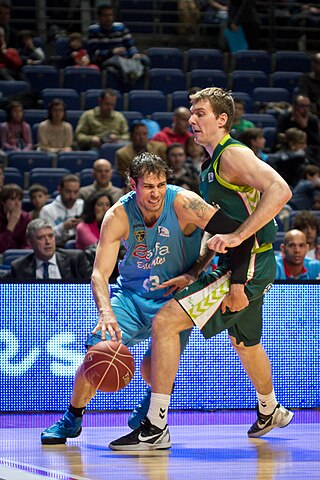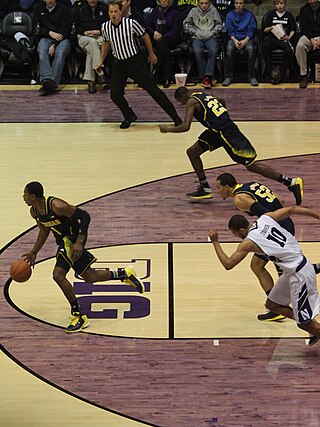Related Research Articles

Basketball is a team sport in which two teams, most commonly of five players each, opposing one another on a rectangular court, compete with the primary objective of shooting a basketball through the defender's hoop, while preventing the opposing team from shooting through their own hoop. A field goal is worth two points, unless made from behind the three-point line, when it is worth three. After a foul, timed play stops and the player fouled or designated to shoot a technical foul is given one, two or three one-point free throws. The team with the most points at the end of the game wins, but if regulation play expires with the score tied, an additional period of play (overtime) is mandated.

The point guard (PG), also called the one or the point, is one of the five positions in a regulation basketball game. A point guard has perhaps the most specialized role of any position and is usually the shortest player on the court. Point guards are expected to run the team's offense by controlling the ball and making sure that it gets to the right player at the right time. Above all, the point guard must understand and accept their coach's game plan; in this way, the position can be compared to the position of quarterback in gridiron football. They must also be able to adapt to what the defense is allowing and must control the pace of the game.

In basketball, a player may attempt to score a basket by leaping straight into the air, the elbow of the shooting hand cocked, ball in hand above the head, and launching the ball in a high arc towards the basket for a jump shot. Although early critics thought the leap might lead to indecision in the air, the jump shot replaced the earlier, less quickly released set shot, and eventually transformed the game because it is the easiest shot to make from a distance and more difficult for a defender to block. Variations on the simple jump shot include the "turnaround jumper" ; the "fadeaway" ; and the "leaning jumper". With the "hook shot," a player is turned sideways with the shooting arm away from the basket outstretched so that with a sweep he can launch the ball over his head. Since a defender must leap to block a jumper, the shooter may use a pump fake to get the defender in the air at the wrong time and so have a clear shot. If the shooter leaps into the defender, a foul is called on the defensive player, whereas the shooter is awarded two or three free throws according to the value of a missed attempt, or a single free throw.

In basketball, a personal foul is a breach of the rules that concerns illegal personal contact with an opponent. It is the most common type of foul in basketball. A player fouls out on reaching a limit on personal fouls for the game and is disqualified from participation in the remainder of the game.

The pick and roll in basketball is an offensive play in which a player sets a screen (pick) for a teammate handling the ball and then moves toward the basket (rolls) to receive a pass. In the NBA, the play came into vogue in the 1990s and has developed into the league's most common offensive action. There are, however, many ways in which the defense can also counter the offensive screen.

In basketball, there are five players on court per team, each assigned to positions. Historically, these players have been assigned to positions defined by the role they play on the court, from a strategic point of view. The three main positions are guard, forward, and center, with the standard team featuring two guards, two forwards, and a center. Over time, as more specialized roles developed, each of the guards and forwards came to be differentiated, and today each of the five positions is known by a unique name and number: point guard (PG) or 1, the shooting guard (SG) or 2, the small forward (SF) or 3, the power forward (PF) or 4, and the center (C) or 5.
Man-to-man defense, or man defense, is a type of defensive technique used in team sports such as American football, association football, basketball and netball, as in which each player is assigned to defend and follow the movements of a single player on offense. Often, a player guards his counterpart, but a player may be assigned to guard a different position. However, the strategy is not rigid, and a player might switch assignment if needed, or leave his own assignment for a moment to double team an offensive player. The term is commonly used in both men's and women's sports. The alternative to man-to-man defense is zone defense, a system of defense in which each player guards an assigned area rather than a specified opponent.
Basketball moves are generally individual actions used by players in basketball to pass by defenders to gain access to the basket or to get a pass to a teammate to score.

Fast break is an offensive strategy in basketball and handball. In a fast break, a team attempts to move the ball up court and into scoring position as quickly as possible, so that the defense is outnumbered and does not have time to set up. The various styles of the fast break–derivative of the original created by Frank Keaney–are seen as the best method of providing action and quick scores. A fast break may result from cherry picking.

This glossary of basketball terms is a list of definitions of terms used in the game of basketball. Like any other major sport, basketball features its own extensive vocabulary of unique words and phrases used by players, coaches, sports journalists, commentators, and fans.
A motion offense is a category of offensive scheme used in basketball. Motion offenses use player movement, often as a strategy to exploit the quickness of the offensive team or to neutralize a size advantage of the defense.

In basketball, a double team is a defensive alignment in which two defensive players are assigned to catch the nut of a single offensive player.

A screen is a blocking move by an offensive player in which they stand beside or behind a defender in order to free up a teammate to either shoot, pass, or to drive in to score. In basketball and field lacrosse, it is also known as a pick. Screens can be on-ball, or off-ball. The two offensive players involved in setting the screen are known as the screener and the cutter.

The key, officially referred to as the free throw lane by the National Basketball Association (NBA), the National Collegiate Athletic Association (NCAA), the National Association of Intercollegiate Athletics (NAIA), and the National Federation of State High School Associations (NFHS), and the restricted area by the International Basketball Federation (FIBA), is a marked area on a basketball court surrounding the basket, where much of the game's action takes place.
Basketball is a ball game and team sport in which two teams of five players try to score points by throwing or "shooting" a ball through the top of a basketball hoop while following a set of rules. Since being developed by James Naismith as a non-contact game that almost anyone can play, basketball has undergone many different rule variations, eventually evolving into the NBA-style game known today. Basketball is one of the most popular and widely viewed sports in the world.
Cherry picking, in basketball and certain other sports, refers to play where one player does not play defense with the rest of the team, but rather remains near half court or closer to their own team's goal.
Wheel offense is an offensive strategy in basketball, developed in the late 1950s by Garland F. Pinholster at the Oglethorpe University. It is a kind of continuity offense in which players move around in a circular pattern to create good scoring opportunities. The wheel offense is a popular offensive play, frequently used by teams from middle school to college levels because it can effectively work against any defense, including zone defense and man-to-man defense.

Killian Deron Antron Hayes is a French-American professional basketball player who last played for the Detroit Pistons of the National Basketball Association (NBA).
The Blocker-Mover or Wheel offense is an offensive scheme used in basketball, primarily, college basketball. The offense was popularized by Dick Bennett when he was the coach at Wisconsin-Green Bay, Wisconsin, and Washington State.
In basketball, the term gravity is used when describing situations in which players without the ball draw defenders to them, simply as a result of their shooting ability being a known threat. This in turn helps their teammates access more open shot opportunities themselves. As the offensive player is deemed a threat by the defending team, the defense collapses in on the player, hence the player is described as having gravity on offense.
References
- 1 2 3 4 5 Nunley, Kim (January 18, 2024). "Back Screen in Basketball: A Basic Guide with Examples". Home School Hoop. Retrieved February 6, 2024.
- ↑ "Better Basketball | Screening Angles for Success". betterbasketball.com. Retrieved February 6, 2024.
- ↑ "Basketball Defending Back Screens". hooptactics.net. Retrieved February 6, 2024.
- ↑ Mahoney, Rob (May 22, 2015). "The power of a Stephen Curry screen". Sports Illustrated. Retrieved February 6, 2024.
- ↑ "Ball Screen Offense—Spain Pick and Roll Explained". Hooper University. Retrieved February 6, 2024.
